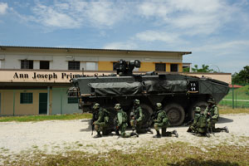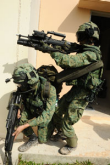OPS & TRAINING
MOTORISED INFANTRY TRAINING: ALL REVVED UP
12 Nov 2010

As the Singapore Armed Forces (SAF) welcomes its latest training school - the Motorised Infantry Training Institute (MTI) - PIONEER finds out how it gives soldiers an edge in motorised infantry operations.
Gone are the days when soldiers had to travel long distances on foot to reach their mission objectives. With armoured vehicles like the Terrex Infantry Carrier Vehicle (ICV), infantry troops can now conserve more energy and better focus on their missions. To increase their efficiency, the SAF has developed its own motorised infantry training competency.
Inaugurated on 8 Oct, the MTI is the newest training institute established by the SAF to provide training and evaluation for motorised infantry training.
MTI commander Senior Lieutenant Colonel Jimmy Toh said: "MTI's mission is to train and sustain committed and professional urban-capable motorised infantry forces. All motorised units will come through the training institute, where we'll train and evaluate them. With MTI, we hope to achieve consistent, realistic and centralised training for all the soldiers across these units."
With the establishment of the MTI, infantry troops now learn to fight alongside the Terrex ICV through the Motorised Infantry Battalion Training Centre (MBTC), the Motorised Infantry Company Training Centre (MCTC) and the Motorised Infantry Training Wing (MTW).
Training for all levels
Explaining the close working relationships among the three training centres, Commanding Officer of MBTC, Lieutenant Colonel (LTC) Jeremy Koh, said: "Essentially, MTW gets the soldiers up to a basic level. The MCTC oversees company-level training, while the MBTC coordinates training and exercises at the battalion level."
Instructors at the MTW train soldiers in either the three-week Terrex ICV Operator Course or the 13-week Motorised Infantry Section Leader Course (MSLC), where trainees are taught the basic operations of the Terrex ICV and learn about maintenance in the context of tactical battlefield movement.
One of the pioneer graduates from the first Terrex ICV Operator Course, Private (PTE) Andre Pong from 2nd Battalion, Singapore Infantry Regiment (2 SIR), believes in being adaptable to keep up with the constantly changing operational environment.
"I've learnt that in our support role, our priority is to help the infantry troops get used to the vehicle and be comfortable operating with it, so that they can defend Singapore better," said PTE Pong.
Indeed, Terrex ICV operators like PTE Pong are aware that their efforts are critical to the success of the main forces.
"These vehicle operators are not just drivers. They are combat personnel who need to transport infantry troops safely to their objectives and they need to be able to fight alongside the infantry troops," added Master Warrant Officer Peter Ang, an instructor at MTI.
Training the trainers
Instructors at MTI also conduct the Terrex ICV Vehicle Commander Course. This train-the-trainer programme is designed to equip various infantry officers and senior specialists who have been slated to assume commander or instructor positions at the 3rd Singapore Infantry Brigade, 2 SIR and MTI with the necessary skills and expertise.
In the absence of a predecessor to model after, instructors at MTI look to their counterparts from the Armour formation for guidance.
"Although we acquire knowledge from the Armour experts, we modify what we have learnt to suit the Infantry's requirements. We also do a lot of our own research and reading," said 1st Warrant Officer Goh Cheong Young, an Infantry soldier who is now a section instructor at MTW.
Soldiers holding appointments of Section 2IC or above are equipped with the ACMS, which helps to track the positions of both friendly and enemy forces.
What started out as a humble Motorised Training Cadre, with only 16 instructors in 2007, has since transformed into a full-fledged training institute with over 50 instructors.
The first Terrex ICV Commander course, which was conducted by instructors at MTW in February, saw 41 soldiers graduating two months later.
About 65 Terrex ICV vehicle operators and another 61 vehicle commanders graduated from the first Terrex ICV Operator and Motorised Infantry Section Leader courses in March and June respectively.
Training with advanced systems
The Terrex ICV was introduced together with other technologically-advanced capabilities, and this required relevant training too.
To improve the infantry soldiers' navigation and communication capabilities, soldiers who hold appointments of section 2nd-in-charge (2IC) or above, don the Advanced Combat Man System (ACMS). This is synchronised with the Battlefield Management System (BMS) mounted on the Terrex ICV. Both systems are connected to networks which allow troops to see the precise locations of fellow forces as well as enemy targets.
"The technology employed in the Terrex like the BMS is very user-friendly. It gives us real time updates and we can find out everyone's exact location this lets us plan and execute our missions with great precision and efficiency," said 3rd Sergeant (3SG) Derrick Chua, a vehicle commander from 2 SIR and a graduate of the first MSLC.
Together with MCTC and MTW, MBTC plays dual roles in producing and advancing the SAF's urban-capable motorised infantry battalions.
"We want to start by focusing on training and generating the capability with 2 SIR, so that when they reach their ORD (Operationally Ready Date), they will be the first NS Motorised Infantry Battalion," said LTC Koh.
With 2 SIR being the first and only motorised infantry battalion that the SAF has at the moment, MTI has been working closely with the unit to develop its training doctrines as well as the tactics, techniques and procedures of how a motorised infantry battalion or unit should operate.
"We may be in the learning phase but we're finding out, exploring and discovering new things as we go along," said LTC Koh.
ALSO READ IN OPS & TRAINING

Exercise Wallaby 2025: To see better, shoot faster
31 Oct 2025
The SAF focuses on complex strike missions and multi-domain integration in Exercise Wallaby 2025, the 35th edition of its largest unilateral overseas exercise.

Ex Wallaby 25 – Greater Integration and Complexity
25 Oct 2025
The 35th edition of the SAF’s largest unilateral overseas exercise is an opportunity for expanded scale and deeper integration towards an effective, networked fighting force.

Ex Forging Sabre ramps up use of unmanned assets in integrated strike operations
12 Sep 2025
In this 10th edition of Exercise Forging Sabre, the SAF sharpened its cutting edge for the dynamic modern battlefield, with expanded integration between manned and unmanned platforms.





